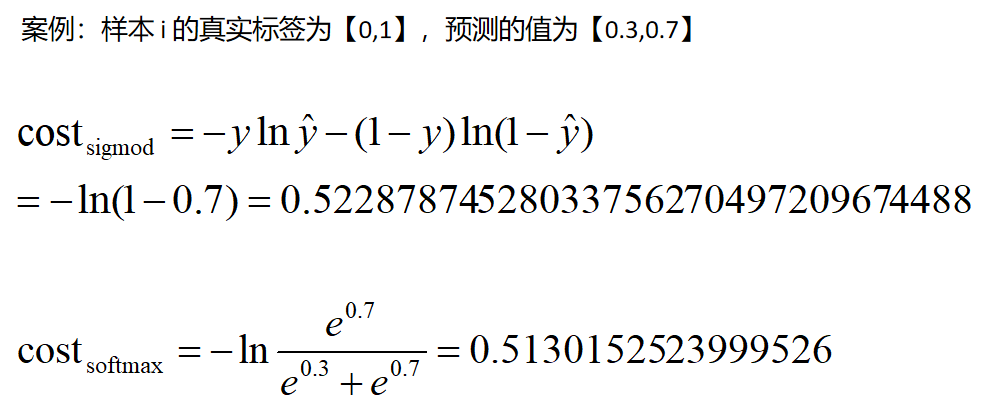深度学习面试题07:sigmod交叉熵、softmax交叉熵
目录
sigmod交叉熵
Softmax转换
Softmax交叉熵
参考资料
|
sigmod交叉熵 |
Sigmod交叉熵实际就是我们所说的对数损失,它是针对二分类任务的损失函数,在神经网络中,一般输出层只有一个结点。
假设y为样本标签,_y为全连接网络的输出层的值,那么,这个对数损失定义为

PS:这个是可以用极大似然估计推导出来的
举例:
y=0,_y=0.8,那此时的sigmod交叉熵为1.171

import numpy as np def sigmod(x): return 1/(1+np.exp(-x)) y=0 _y=0.8 -y*np.log(sigmod(_y))-(1-y)*np.log(1-sigmod(_y)) #_y-_y*y+np.log(1+np.exp(-_y))
|
Softmax转换 |
假设向量x=(x1,x2,...,xm),对x进行softmax转换的处理方式为:

显然,x进行softmax处理后,会归一化为[0,1],且和为1
举例:假设x=[0,2,-3], softmax(x)=[0.11849965, 0.8756006 , 0.00589975]

import numpy as np a = np.array([0,2,-3]) y = np.array([1,0,0]) softmax = np.exp(a)/sum(np.exp(a))
|
Softmax交叉熵 |

在神经网络的多分类中,假设是3分类,那么输出层就有3个神经元。
假设神经网络对某个样本的输出为out = [4,-5,6],样本的真实标签为[0,0,1],此时的softmax交叉熵为0.1269,计算公式为:
①首先对[4,-5,6]做softmax转换,softmax(out)=[1.19201168e-01 1.47105928e-05 8.80784121e-01]
②sum(-y*log(softmax(_y)))

import numpy as np out = np.array([4,-5,6]) y = np.array([0,0,1]) softmax = np.exp(out)/sum(np.exp(out)) sum(-y*np.log(softmax))
Demo2:

import numpy as np import tensorflow as tf # 方式1 out = np.array([[4.0, -5.0, 10.0], [1.0, 5.0, 4.0], [1.0, 15.0, 4.0]],dtype=np.float64) y = np.array([[0, 0, 1], [0, 1, 0], [0, 1, 0]],dtype=np.float64) softmax = np.exp(out) /np.sum(np.exp(out),axis=1).reshape(-1,1) res = np.sum(-y * np.log(softmax))/len(y) print(res) # 方式2 res2 = tf.losses.softmax_cross_entropy(onehot_labels=y, logits=out, label_smoothing=0) print(tf.Session().run(res2)) # 方式3 res3 = tf.reduce_mean(tf.nn.softmax_cross_entropy_with_logits_v2(labels=y,logits=out)) print(tf.Session().run(res3)) 0.10968538820896588 0.10968538373708725 0.10968538820896594

|
参考资料 |
《图解深度学习与神经网络:从张量到TensorFlow实现》_张平






 浙公网安备 33010602011771号
浙公网安备 33010602011771号